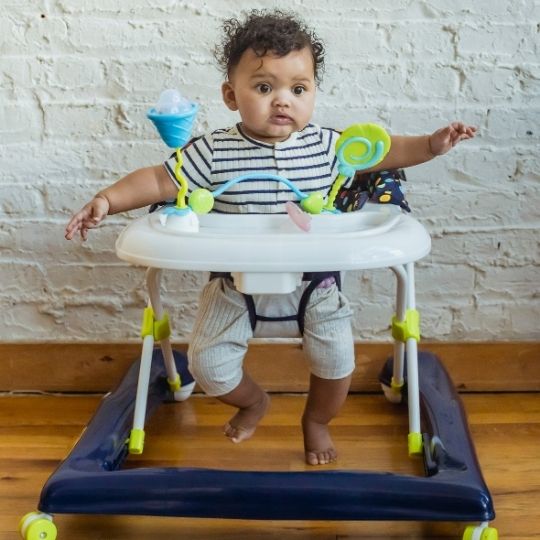I’ve been adamant about avoiding using a baby walker with my daughter, Tori. So much so, that I took issue when our childcare provider used one at daycare. When I wrote an instagram post about it, I received an overwhelming amount of responses and questions.
First off, if you have used one or are currently using a baby walker, don’t feel called out. I am here to provide information and you can take or leave depending on what fits your family needs the best.
When I say walker, I am talking about the one that has a seat in the center and wheels on the bottom, like the one pictured above. This product has been banned in Canada since 2004. The American Academy of Pediatrics (AAP) has also called for a ban on these and their website actually states “baby walkers are never safe to use, even with an adult close by.”
Safety Concerns with a Baby Walker
- Safety is always a concern for parents and also my primary reason for wanting to avoid baby walkers for my daughter. Depending on which source you look at, when a child is in a walker, they can move 3-4 feet per second! No matter how attentive the adult is, the child is still moving faster than you can react.
- The speed is what leads to other scary things like head injuries. Being closer in height to things with sharp corners or near stairs. It doesn’t matter if it’s just one or several, the child can go tumbling fast.
- The base of the walker also provides a way for the child to climb. That means they will be able to reach for things we as caregivers don’t want them to touch. Like chemicals, hot surfaces, choking hazards, etc.
Development Issues with a Baby Walker
- Developmentally, caregivers tend to use this because they think it will help the child walker sooner. Unfortunately, it could actually have the opposite effect. The way a child moves while in the walker is very different from a gait pattern while walking independently. This means they will likely have to learn to balance in a totally different way. Different muscles are needed to hold themselves up so developing the strength in those could take more time.
- Toe walking also becomes a risk. Oftentimes, the height of the walker is not optimal and causes only the child’s toes to be on the ground which fires the muscles in the calf and strengthens them. They can become chronically shortened and over developed if this is used too much and can lead to them walking on their toes rather than rolling through the entire foot.
- Changes to the hip are also a concern I have, especially if the walker is used before 7-8 months of age. The hips are not designed to take the weight of the child in those early months. The progression of the milestones is there for a reason and we want to allow the child to go through this progression in order. (Yes, there are some extenuating circumstances that altering this is appropriate, but for the average child, rolling, sitting/crawling, pulling to stand/cruising then walking is the order that is most appropriate.)
What to do Instead
- Create a “YES” space. This is an area that absolutely everything is safe for the child to play and interact with. There are no choking hazards, all the toys are age appropriate, there is room to move around, etc. This allows the child to interact with their surroundings and we know this promotes development.
- Play with them at varying heights. I have a few other blog posts about other stages of development, but if your child is ready to stand, read this blog to understand the importance of standing play.
- Schedule an appointment with me to discuss other options or to take a look at your child’s body to see if there is lack of motion in the spine or joints of the extremities or some muscle imbalances. You can schedule with me here!
Again, try not to stress if you have not avoided a baby walker with your child to this point. It is ok to make changes in what you are doing. And you don’t know what you don’t know, which is why I am here to provide information for you. If you have any questions, please feel free to email me.





